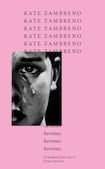

To mark the publication of author and critic Kate Zambreno’s new book, The Light Room, Corsair are republishing her cult classic text, Heroines, first published more than a decade ago in the US. This review discusses both books.
Heroines is a book of “gooshy, goopy, confessions”, a “bulimic” manifesto for, what Jamie Hood describes in an introduction to the book as the “chaotic sadgirl and her unclassifiable art of too-muchness”.
Zambreno, whose writing drew fame from her former blog, Frances Farmer Is my Friend, was a pioneer of auto-theory and hybrid memoir. Heroines is a polemic that explores the pathologising of “mad” women, and the subjugation of literary wives and mistresses including Vivien(ne) Eliot, Zelda Fitzgerald and Jean Rhys (although much of the text is preoccupied with fictional female characters written by male authors, in particular Emma Bovary).
The prose is a gluttonous and performative. “My mode of reading is masturbatory,” she writes. “Sometimes I feel guilty about my lubed fingers all over library books.” The author seems at once to be criticising and propagating the hypothesis that “a woman is nature, violence, instability”.
The 100 best Irish books of the 21st century: No 25 to No 1
The 100 best Irish books of the 21st century: No 50 to No 26
The 100 best Irish books of the 21st century: No 100 to No 51
The Age of Diagnosis by Suzanne O’Sullivan and No More Normal by Alastair Santhouse: Intelligently exploring questions of immense public importance
in The Light Room, Zambreno shifts the angle of the lens. Discussing art, as a means of looking outwards, she is no longer in selfie mode
However, if Heroines is a book of feverish nocturnal ramblings, The Light Room reads more like meditations of the half-light. Set during the pandemic, Zambreno, now a mother to two small children, reflects on motherhood and care. Her prose is poised and embellished once again with literary criticism, including discussions of the work of Joseph Cornell and Natalia Ginzburg.
Zambreno discusses an essay about a writer who didn’t want to “be a mother because she didn’t want to become a landscape”. Herein lies the primary point of contrast between the two texts: in The Light Room, Zambreno shifts the angle of the lens. Discussing art, as a means of looking outwards, she is no longer in selfie mode, where the histories of literary wives are employed to narrate her own story.
In the final section of The Light Room, Zambreno switches to third-person narrative, which lends a universality to the themes of “the vertiginousness of early motherhood, of exhaustion and despair and small joys”. The labour of love and the love in our labour.
Both books end with a yearning for change; “We exaggerate the importance of what we can do alone”, Zambreno references theorist Silvia Federici, in The Light Room. “Fuck you,” she writes at the end of Heroines, “to the objective correlative. Fuck the canon. Fuck the boys with their big books.”













